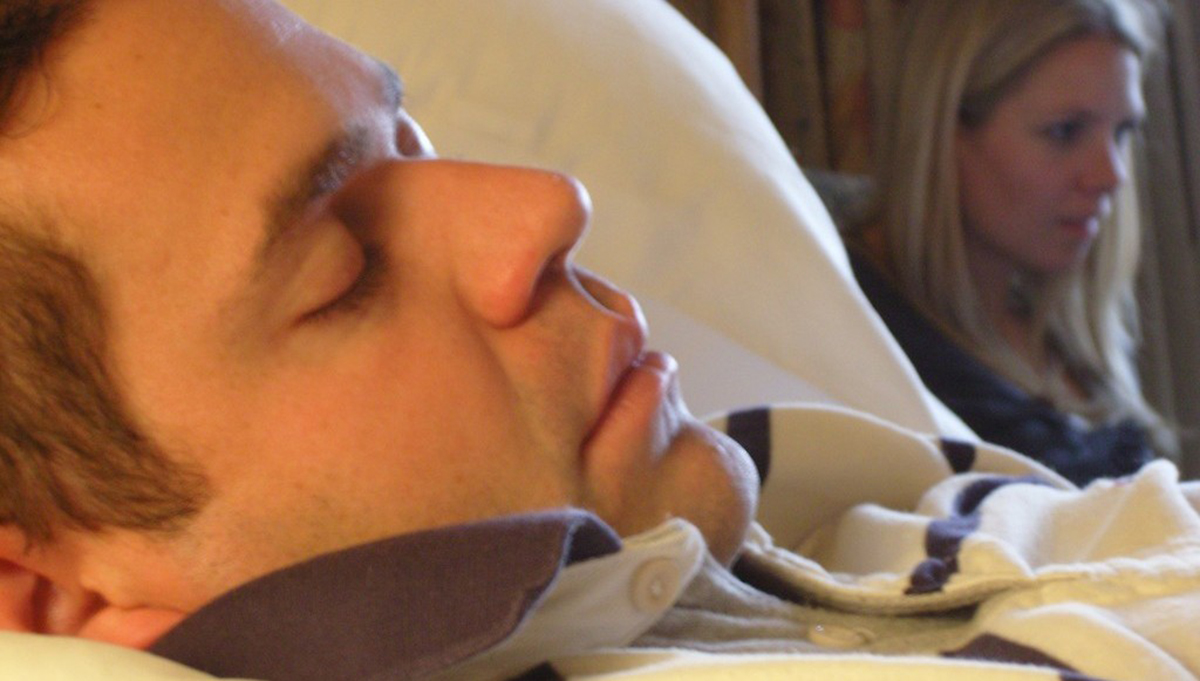Sexsomnia
Sexsomnia is a sleep disorder in which the affected individual is engaging in sexual activities of any sort while asleep. It is further classified within the sleep disorder group of parasomnias, it can occur alongside other sleep disorders such as sleep walking, bed wetting, night terrors or sleep apnea.

Generally, the individual suffering from this disorder does not remember anything of the episodes. Sexsomnia is thought to be caused by relationship issues with one’s intimate partner. The issues can be emotional in nature, or related to sexual problems. Sexsomnia can also be caused by alcohol abuse, sleep-deprivation or stress. Sexual acts commonly performed in sexsomnia include masturbation, fondling (of oneself or another person), sexual intercourse, and even sexual assault and rape. As a matter of fact, there have been several cases of sexual assaults and rapes reported by the press, and caused by sexsomnias. In all cases, the prosecuted individuals were found not guilty due to their medical condition. Because sexsomnia primarily arises from an anxiety disorder, it can be treated with psychotherapy and antianxiety medications. Psychotherapy should aim at identifying the sources of anxiety in the patient’s life and resolving any internal conflict that might trigger the condition.
Couvade Syndrome
Couvade syndrome is a psychological condition with physiological symptoms in which a partner experiences some of the same symptoms of pregnancy as the pregnant and expecting mother. It is also called sympathetic pregnancy. Commonly experienced symptoms are morning sickness, disturbed sleep pattern, weight gain and altered hormonal levels. In more severe cases, the patient suffering from Couvade Syndrome even experiences postpartum depression and labor pains. Several theories have been put in place in an attempt to explain how one’s pregnancy can have such a strong physiologic effect on their partner. The physiological theories that explain this syndrome stipulate that when a partner is living under the same roof as their expecting female partner, they experience hormonal shifts in their levels of cortisol, estrogen, progesterone and prolactin; which are all involved in pregnancy development and sustainance. However, Osvlosky and Culp (1989) support a more psychological theory to this condition. According to them, with the upcoming of a new born in the family, the male counterpart might experience anxiety and a certain level of rivalry.
Diphallia
Diphallia or penile duplication is a medical condition in which a male infant is born with two penises. Diphallia occurs alongside with other congenital and developmental abnormalities such as renal, vertebral or Anorectal anomalies.
Diphallia is thought to be caused by an injury in utero that occurs within the teratogenic period (more specifically, weeks 3-8). The injury could vary from oxidative stress, chemical stress that could cause gene malfunction (specifically the homeobox genes). The homeobox genes are critical genes during embryogenesis, and they work to ensure adequate cellular division and migration during organogenesis.
See Also: Erectile Dysfunction - Causes And Risk Factors
There have been cases of males living successful and happy lives with diphallia, and being able to have proper sexual intercourses with their female partners. Regarding their fertility potential, men with diphallia are able to make children, but in some cases there could be deeper anomalies that could hinder that ability, thus rendering them (unfortunately) sterile.
Diphallia Vs Genital Bisection
Diphallia should not be confused with genital bisection which is an intentional medical procedure through which the genitals (most commonly, the penis) is split in two equal halves to achieve more pleasure during the sexual act. Some cases of genital bisection involve splitting the scrotum (in addition to the penis). It can occur after or alongside with a meatomy which is a medical procedure in which the underside of the penile glans is split in two to provide further pleasure.

Priapism
Priapism is a medical condition characterized by a sustained erection for long periods of time. This condition is particularly dangerous because if the erection is sustained for more than 4 hours, irreversible ischemic changes would take place, leading to necrosis of the penis.
In a world where one a lot of men suffer from erectile dysfunction, having a sustained erection (for a man) might seem like quite achievement, and might even give him false ideas of being able to achieve longer sexual intercourses. However, this is not true, if we understand the physiology of erection and sexual intercourse in men. For men, after erection and once the plateau of sexual excitement is reached (orgasm), ejaculation takes place. To reach a new plateau and allow a new cycle of sexual excitement, hormones levels should progressively be lowered and the muscular layers of the penis should progressively relax before starting over again, and this process generally takes a couple of hours. Therefore, even if one’s penis remains erect for a sustained period of time, it is not synonymous to longer excitement but instead, could increase the risk of damage. Priapism can be caused by a wide variety of diseases, but also some medications (including antidepressants).
Hypersexuality (Nymphomania, Sexual Dependency)
Hypersexuality is a disorder encountered more commonly than it is reported. It is characterized by a dysfunctional preoccupation with sexual fantasies as well as extremely frequent sexual urges, which both push the affected individual to seek satisfaction of those urges and realization of these fantasies through the media of sexual intercourses (casual and non casual), compulsive masturbation and pornography.
See Also: Erogenous Zones and Sexual Response
As far as the cause of hypersexuality is concerned, researchers are still unable to identify an isolated factor. Rather, it is believed that a compilation of factors come in place together to render an individual addicted to sex. The temporal and frontal lobes are the parts of the brain responsible for regulating libido and personality. Therefore, brain injuries that affect those areas of the brain could result in hypersexuality and personality changes such as aggressively or inappropriate behaviors. Hypersexuality is also present in women prior to their menses, which could indicate a hormonal factor as well. Similarly, exposure to male hormones in utero and even in childhood is thought to be a contributing factor to hypersexuality in males.
- Photo courtesy of bradleypjohnson by Flickr : www.flickr.com/photos/bradleypjohnson/346245002
- Photo courtesy of jammmick by Flickr : www.flickr.com/photos/jammmick/6152517456
- en.wikipedia.org/wiki/Sleep_sex
- en.wikipedia.org/wiki/Couvade_syndrome
- www.princeton.edu/~achaney/tmve/wiki100k/docs/Diphallia.html
- http://en.wikipedia.org/wiki/Diphallia http://emedicine.medscape.com/article/437237-overview#aw2aab6b2b3
- psychcentral.com/lib/hypersexuality-symptoms-of-sexual-addiction/00011488

